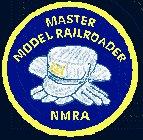Picture Gallery
1. The layout begins with this scene depicting the outskirts of a logging camp in the woods, where logs were cut and loaded onto cars for transport to a sawmill, where they were made into finished lumber.
The backdrop is hand painted, using blue latex paint for the base sky and clouds, and artist acrylics for the landscape.
2. The track proceeds through the small town of Magnolia, which includes a transfer freight house, where goods can be transferred between the narrow gauge FLC and the standard gauge Illinois Central railroads. Magnolia has a stock yard and a couple of industries which transport freight on the FLC, and a siding where trains can meet and pass each other.
3. From Magnolia, the route continues on to the mill at Fernwood, where the logs are unloaded with a steam crane and dumped into the log pond, from where they are then hauled up a ramp into the mill to be sawed into boards, and later shipped out as finished lumber.
The track is hand-laid, and consists of pine ties stained and glued to the sub-roadbed, after which metal rails were spiked to the ties, using a gauge to ensure the correct spacing. Then red clay dirt, which was brought up from the South for this purpose, was added for the ballast. Most of the buildings are also scratch-built, using wooden coffee stirrers for the siding.
4. The blacksmith shop at the camp has a fully detailed interior, complete with blacksmith, forge, bellows, tools and workbenches, and other details, including a glowing ‘fire’ in the forge. Ask to see the roof removed if you’d like to see the interior details.
5. Another highlight at the camp is the small freight house, which was built according to the specifications and drawings for one on the real Fernwood Lumber Company railroad.
6. All of the logging cars on the layout were also scratchbuilt, but use commercially available trucks, couplers, and some detail items.
7. It was a lot of fun and a
great learning experience to build the railroad, and I picked up many new
skills along the way, thanks in large part to the National Model Railroad
Association’s Achievement Program, which encourages and acknowledges members
for striving for greater levels of accomplishment in modeling, on the way to a
Master Model Railroader certificate.

I hope you’ve enjoyed this short tour, and that if you have an interest in model railroading you’ll consider joining the National Model Railroading Association, and participate in our local division’s clinics, tours, and other activities. Have fun!